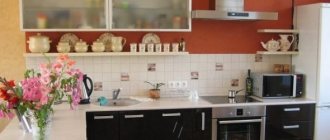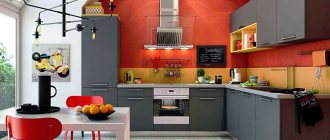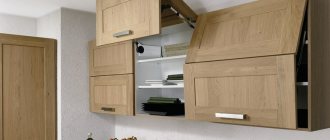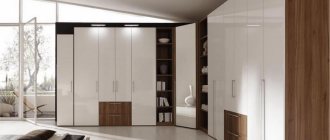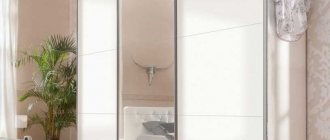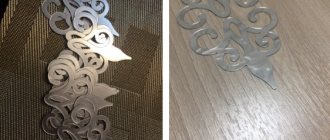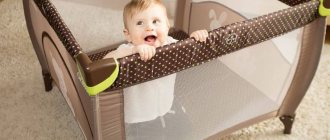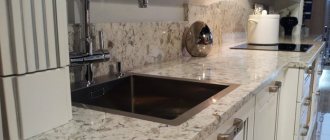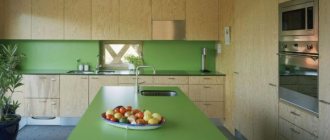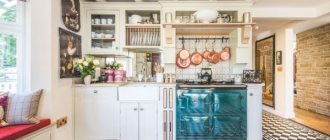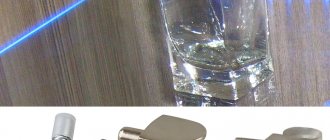The simplest and most affordable method of attaching a cabinet to a partition or plasterboard wall is to use butterfly dowels as fasteners. This option is suitable for structures whose weight does not exceed 5 kg. The dowels are screwed into the material using a screwdriver, and then a screw is screwed into them. The use of a “butterfly” mechanism effectively protects the fastening element from turning and falling through.
If you need to hang a cabinet weighing up to 15 kg on a plasterboard wall, the optimal solution would be to use intermediate strips. They are fixed in different places using screws and anchors. Then the necessary structures are attached to them.
To place large and heavy furniture on a plasterboard wall, use extended type anchor bolts. Work stages include:
- Making holes in the wall through the gypsum board using a drill or hammer drill (the depth should be on average 0.5 cm longer than the anchor).
- Anchor bolts are inserted through the resulting recesses (level with the plasterboard sheet). To securely fix them, a special key is used.
- A washer is placed on the thread of the bolt, a loop from the locker, then a washer again, and the whole thing is screwed on with a nut.
A fairly universal fastener is the spacer. It is installed to match the level of furniture fastening. When installing the structure on the partition, appropriate marks are made. Furniture fasteners are screwed to a strong base without any problems.
Mortgages made of wooden beams, drywall profiles, brackets and other elements are mounted into the frame approximately where it is planned to make holes for fastening structures.
Method 1. Installation of embedded beam
The embedded elements are pre-installed into a wall or partition made of plasterboard at the required height during the installation of the frame.
A huge advantage of this method is the ability to securely screw the cabinet fastenings anywhere along the entire length of the embedded elements.
Mortgages do not require any additional costs. Essentially, these are additional horizontal jumpers of the frame made from scraps of a rack profile with wooden blocks embedded in them.
The combination of profile and timber has a number of advantages compared to purely wooden mortgages:
- There is no need to select a beam that is ideally suited to the thickness of the partition - the required thickness of the frame will be determined by the profile. The pieces of timber are screwed to it with self-tapping screws during the installation process and do not dangle;
- The metal “shirt” from the profile protects the timber from cracking and provides additional rigidity.
The method with embedded elements is often used if it is necessary to hang kitchen cabinets (especially on a plasterboard partition), when there is simply no possibility of attaching to a solid wall.
Installing mortgages is the most reliable way to hang a cabinet on a plasterboard wall.
The disadvantage of this fastening method is the need to know in advance the dimensions and location of the wall cabinets, which is not always known at the installation stage.
Method 3. Plastic and metal wrap-around dowels
This is the fastest option for hanging a cabinet from a plasterboard wall. The downside is a significant limitation on the maximum load. The video below demonstrates what load different types of dowels can withstand:
For fastening, special roll-up dowels for DRIVA plasterboards are used. They come in metal and plastic, with or without a drilling tip, and have large external threads and a cross slot for screwing into drywall with a screwdriver. In contrast to previous methods, these fasteners should not get into the metal frame profiles.
DRIVA is simply screwed into the plasterboard sheet in the right place, its end is flush with the plane of the wall. The force when screwing should be controlled so that the dowel does not “fall” through the gypsum board. To fasten hanging furniture, self-tapping screws or self-tapping screws are screwed into DRIVA.
Advice! To avoid distortions when screwing in dowels, you can pre-drill the gypsum board with a regular drill of a smaller diameter.
The declared maximum load on DRIVA fasteners is 25 kg. At the same time, we should not forget about the additional dynamic loads that arise during operation. Craftsmen recommend using DRIVA for attaching small cabinets, shelves, plasma panels and paintings to drywall.
Another innovative solution is the use of the Fischer DuoTec self-aligning dowel. The principle of its operation and installation technique can be seen in the video:
Let's look at an example of how to hang a cabinet in the kitchen using a mounting rail.
Tools you will need:
- Impact drill or hammer drill.
- Several dowels with a diameter of 10 mm and a length of at least 6 mm.
- Two canopies and a mounting plate.
- Metal scissors or jigsaw.
- Concrete drill with a diameter of 10 mm.
- Drills 4 and 2 mm.
Fastening awnings
Let's prepare a cabinet for attaching awnings. To do this, if it is not removed, dismantle the back wall. It is usually made of fiberboard. We insert the canopy inside the cabinet and make sure that its upper part fits snugly against the cabinet body.
The hook, when released, should extend beyond the cabinet body by 4mm.
Use a 4 mm drill to drill a through hole for attaching the canopy.
We do not drill the second hole for fastening the canopy through it, but go through it with a 2 mm drill to screw in the screw.
In practice, two fastenings use screws, but for greater reliability it was decided to use a through screw and nut. The disadvantage of this method is that the screw head will be visible on the side of the cabinet. But even with ordinary screws the cabinet will not fall off.
How to hang a wardrobe on a loose wall
Foam blocks and cinder blocks are classified as “loose” building materials to which it is difficult to attach fasteners. Also, adobe, adobe and wooden walls cause certain difficulties.
The choice of fasteners depends on the type of material and the planned load (weight of the loaded cabinet). It can be a screw fastener or a “butterfly” or “umbrella” type drop-down fastener. Long anchor bolts perform well in practical applications. You can drill with a thick drill bit (diameter from 8 mm) and strengthen the fastening point using wooden plugs or special glue for subsequent screwing in the self-tapping screw. Or immediately use “chemical” anchors.
There are plenty of options. Specialized construction stores will help you decide on the best solution. For any type of wall you can choose the best option. Combinations of several types also perform well.
Additional advice from experts on installing cabinet fasteners
Adviсe:
- Vibrations of the drill at the beginning of drilling can be eliminated by first punching a small hole with a punch.
- To prevent the wall from crumbling, reduce the diameter of the drill.
- The depth of the hole is controlled using a mark on the drill.
- Before drilling, determine the location of the electrical wiring.
Having chosen the fastening option, taking into account the strength and material of the walls in the room, having prepared the place and tools, you can safely get to work.
Did you manage to solve your problem using the recommendations from the article?
Yes!
46.06%
No. More answers required. I'll ask in the comments now.
37.9%
Partially. There are still questions. I'll write in the comments now.
16.03%
Voted: 343
Advantages of tire mounting
A fastening system has proven itself, consisting of a rail, which is a perforated strip of metal with a protruding part designed to be held by hooks located on the inside of cabinets.
Such a mount has a number of obvious advantages:
- quick installation, accessible to a beginner;
- cabinets can be hung effortlessly on a prepared rail, without helpers;
- if leveling is necessary, the height is adjustable;
- the fit of the cabinet after hanging it can also be adjusted in depth;
- The tire can be divided into pieces of the required length.
In the store, you should pay attention to the package, since fastenings in the form of tires and canopies may be included in its composition. In this case, you can be sure that the manufacturer has foreseen the possible load and provided reliable fasteners.
When starting to hang kitchen cabinets, you need to secure the awnings to them with self-tapping screws, placing the hooks in the middle position. Another position is allowed, but this is considered the most optimal.
Using a level, the position of the tire is marked on the wall, holes are drilled and the structure is secured with dowels. Once the cabinet is securely installed, a control measurement of its exact position is carried out. If necessary, it is leveled. If several hanging pieces of furniture are placed nearby, they are fastened together using a clamp. It is advisable to lay thin insulating material between the walls to avoid damage.
Which mounts to choose: tips
To hang a cabinet on a plasterboard wall, choose the following fasteners:
- Plastic dowels - “butterfly”. Withstands a load of 24 kg. Light objects such as shelves, small paintings, small cabinets are hung on it.
- Metal adjustable dowel “Molly”. The principle of operation of the fastener is the same as that of the “butterfly”. It can withstand a load of 35 kg.
- Metal anchor. This fastener is used for hanging heavy chandeliers and heavy objects. It can withstand loads of up to 50 kg. Therefore, hanging a cabinet on it will not be difficult.
- Dowel Driva. Made from plastic (hanging 25 kg) and metal (holding 30 kg).
- "Harmut Knauf" - this mount can withstand 55 kg. At the same time, the plasterboard surface will remain the same flat.
Choosing fasteners for hanging a cabinet is a responsible matter. Not only the weight of the furniture is important here, you need to consider what will be put in it, and what the weight will be if the cabinet is full.
Before hanging the cabinet on the gypsum plasterboard surface, it is necessary to make precise horizontal markings. The weight of the filled furniture should be taken into account. The use of mortgages is the best option. If rearranging or updating furniture is done after repairs, then you need to select fasteners taking into account their withstand load.
Hanging corner
An old but effective way to attach any furniture to the wall
The system of fastening cabinets using a rigid corner with two holes for fastening to a cabinet and hanging has been known since old Soviet times.
Through holes are drilled along the edges of the frame, in the upper part of the cover, through them, using a bolt and nut, the corners are fixed flush with the back wall, they are hung on self-tapping screws screwed into the dowel. The mounting system is very reliable; it allows you to adjust only the height of the suspension.
Apartment redevelopment
Every owner dreams of making his home unique. In new buildings, even at the construction stage, the customer can plan himself where the partitions and doorways will be located. Another thing is Soviet-built houses, which were built according to standard designs with small rooms and a tiny kitchen. In this regard, owners of “Khrushchev” apartments are increasingly beginning to think about the need to redevelop their apartments. They cut out or dismantle part of the walls for openings, combine loggias with kitchens, one room with another.
For any redevelopment involving partial destruction of partitions or walls, it is necessary to provide measures to strengthen them. It should be noted that dilapidated structures are recommended to be completely dismantled in order to avoid emergency situations, and openings in load-bearing walls need to be reinforced with stronger structures, and specialists with special approvals must be involved in the work. In addition, coordination and registration of permits with the relevant services is necessary. Without complying with these requirements, breaking load-bearing walls is strictly prohibited!
In case of redevelopment, the walls are reinforced with metal corners and channels. Such a strengthening, if installed correctly, will be quite reliable and will last for decades. Metal profiles are subsequently masked using finishing materials, so they do not have any effect on the appearance of the room.
The installation of the reinforcing structure is carried out within one day, and the process itself includes several steps:
- the contour of the future opening is marked in place and then measured;
- holes are made in the floor on both sides of the opening into which fastening plates are inserted;
- Through cuts are made along the vertical marks, and racks for the corners are installed, which are subsequently tightened with bolts;
- a hole is punched along the horizontal marking along the opening, and a channel is inserted into it (it will have to rest on the corners);
- on the other side of the wall, fastening plates are also installed in the floor, corner racks are installed in the vertical cuts, and a channel is installed in the horizontal cuts;
- the channels are tightened with bolts, and the joints on the outside are welded;
- the required opening is cut out;
- Angles are welded to the posts, mounting plates and channels.
The above-described method of strengthening a wall when creating openings in existing structures is one of the options for strengthening. To determine how the building envelope will be strengthened, you should invite professionals who can offer their own option based on the specific situation.
Step-by-step instructions for 2 hanging options
Two methods of installing the upper block are used: in the first case, different types of fastening fittings (corners, hinges) are used, in the second case, a mounting canopy formed from a wall strip is used. Regardless of the chosen option, the fittings are first screwed to the furniture, then markings are formed on the wall for it.
Ordinary method
In the traditional hanging scenario, the corners and hinges are screwed almost identically:
- the fasteners are applied to the edge of the block and the entry points of the screws are marked with a pencil;
- If the hinges are fixed with self-tapping screws, holes are formed for them, the diameter of which should not exceed 2 mm. When using a furniture confirmator, you need to arm yourself with special drills with the same marking;
- the loops are screwed to the object being hung. Self-tapping screws used in relation to the side wall must be no shorter than 50 mm;
- When the hinges are securely fixed, it becomes possible to accurately measure the level of installation of fasteners that will be placed on the wall. It is important to fix the distance between working points;
- for hanging heavy modules, anchors with a diameter of at least 6-10 mm are used, light blocks are placed on metal hooks, similar in structure to self-tapping screws;
- when using powerful anchors, drill a hole into which the fasteners are placed; later it can be tightened after hanging the cabinet. A plastic dowel is hammered into the holes intended for light hooks and the fittings are screwed in.
